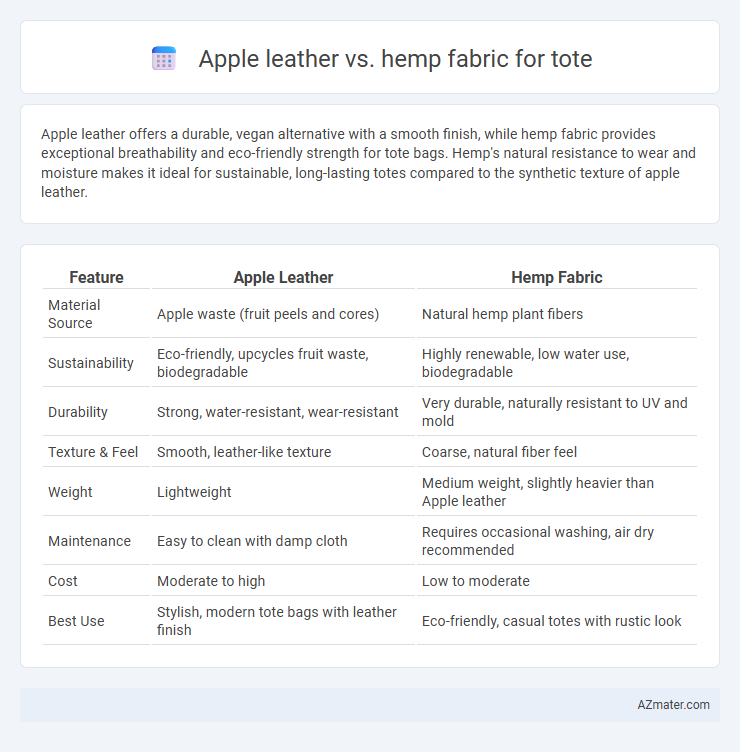Apple leather offers a durable, vegan alternative with a smooth finish, while hemp fabric provides exceptional breathability and eco-friendly strength for tote bags. Hemp's natural resistance to wear and moisture makes it ideal for sustainable, long-lasting totes compared to the synthetic texture of apple leather.
Table of Comparison
| Feature | Apple Leather | Hemp Fabric |
|---|---|---|
| Material Source | Apple waste (fruit peels and cores) | Natural hemp plant fibers |
| Sustainability | Eco-friendly, upcycles fruit waste, biodegradable | Highly renewable, low water use, biodegradable |
| Durability | Strong, water-resistant, wear-resistant | Very durable, naturally resistant to UV and mold |
| Texture & Feel | Smooth, leather-like texture | Coarse, natural fiber feel |
| Weight | Lightweight | Medium weight, slightly heavier than Apple leather |
| Maintenance | Easy to clean with damp cloth | Requires occasional washing, air dry recommended |
| Cost | Moderate to high | Low to moderate |
| Best Use | Stylish, modern tote bags with leather finish | Eco-friendly, casual totes with rustic look |
Introduction: Apple Leather vs Hemp Fabric for Totes
Apple leather offers a sustainable alternative to traditional animal leather, made from the byproducts of apple juice production, boasting durability and water resistance ideal for stylish tote bags. Hemp fabric, derived from the fibers of the hemp plant, is known for its exceptional strength, breathability, and eco-friendly cultivation with low environmental impact. Choosing between apple leather and hemp fabric for totes involves considering durability, texture, and sustainability preferences specific to each material's unique properties.
Sustainability Comparison: Apple Leather and Hemp
Apple leather, made from apple peel waste, offers a biodegradable and vegan alternative to traditional leather with lower water consumption and reduced carbon footprint, enhancing sustainability. Hemp fabric is highly sustainable due to its rapid growth, minimal pesticide use, and soil regeneration properties, making it a renewable and eco-friendly choice for tote bags. Both materials provide environmentally conscious options, with apple leather excelling in waste valorization and hemp fabric offering superior crop sustainability and durability.
Material Origins: How Apple Leather and Hemp are Made
Apple leather is derived from the byproducts of apple juice and cider production, where apple peels and cores are processed and combined with polyurethane to create a sustainable, vegan alternative to traditional leather. Hemp fabric comes from the fibers of the stalks of the Cannabis sativa plant, which are harvested, retted, and spun into a strong, breathable textile favored for its durability and environmental benefits. Both materials emphasize eco-conscious origins, with apple leather using fruit waste and hemp fabric relying on a fast-growing, low-impact plant resource.
Durability and Longevity
Apple leather offers excellent durability with its resistant surface that withstands daily wear and tear, making it ideal for long-lasting tote bags. Hemp fabric is renowned for its strength and natural resistance to abrasion and stretching, ensuring a robust and enduring tote material. Both materials provide sustainable alternatives with hemp fabric typically offering superior breathability and longevity in diverse weather conditions.
Environmental Impact and Footprint
Apple leather, made from apple waste, offers a biodegradable alternative to traditional leather, reducing reliance on animal farming and minimizing water and chemical use in production. Hemp fabric boasts a low environmental footprint due to its rapid growth, minimal pesticide requirements, and excellent soil regeneration properties, making it a highly sustainable option for tote bags. Both materials contribute to reducing carbon emissions, with hemp fabric generally having a smaller overall footprint due to its organic cultivation and carbon sequestration capabilities.
Style, Texture, and Aesthetic Appeal
Apple leather offers a smooth, supple texture with a sleek, modern aesthetic that mimics traditional leather, enhancing the tote's sophisticated style. Hemp fabric provides a coarse, natural texture with an organic, earthy appeal, lending the tote a casual and eco-friendly vibe. Both materials deliver unique visual and tactile experiences that cater to different fashion preferences and sustainable choices.
Cost and Accessibility
Apple leather tote bags typically cost more due to the advanced processing required to transform apple waste into durable material, making them less accessible but appealing to eco-conscious consumers seeking innovative alternatives. Hemp fabric totes are generally more affordable and widely available because hemp is a fast-growing crop with established textile manufacturing, providing a cost-effective and sustainable option for everyday use. Consumers balancing budget and environmental impact often prioritize hemp fabric for its accessibility, while Apple leather attracts those willing to invest in niche, plant-based luxury.
Vegan and Eco-friendly Claims
Apple leather and hemp fabric both offer sustainable alternatives for vegan tote bags, with apple leather deriving from apple waste and hemp fabric grown as a fast-renewable crop that requires minimal pesticides. Apple leather provides a leather-like texture while being free from animal products, supporting cruelty-free and biodegradable claims. Hemp fabric boasts excellent durability and breathability, contributing to reduced environmental impact through organic cultivation and lower water consumption.
Maintenance and Care for Tote Bags
Apple leather tote bags require gentle cleaning with a damp cloth and mild soap to maintain their smooth, eco-friendly surface while avoiding harsh chemicals that might damage the material. Hemp fabric totes offer durability and easy care, tolerating machine washing or spot cleaning, and maintaining strength with minimal fading over time. Both materials benefit from air drying away from direct sunlight to preserve shape and longevity, making maintenance practical and sustainable for daily use.
Which Tote Material is Right for You?
Apple leather offers a sustainable, cruelty-free alternative with a smooth texture and water-resistant qualities, ideal for those seeking a stylish yet eco-conscious tote. Hemp fabric stands out for its durability, breathability, and natural resistance to mold, making it perfect for heavy use and a more rustic, organic look. Choosing between Apple leather and Hemp fabric depends on your priorities: opt for Apple leather if you want a vegan, polished finish, or select Hemp fabric for robust, eco-friendly practicality.

Infographic: Apple leather vs Hemp fabric for Tote
 azmater.com
azmater.com